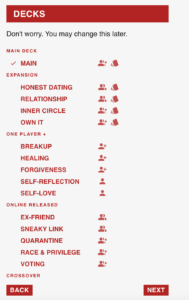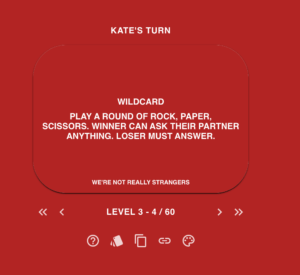Basic Information
I chose to play We’re Not Really Strangers, which was originally created by a company of the same name—We’re Not Really Strangers (and invented by Koreen Odiney)—in November 2018. The official website for the game can be found here. The game is designed to create meaningful connections between both close friends and those meeting for the first time. According to the game’s box, it is intended to be played by those 15 years of age and older; I suspect this is because it encourages vulnerability and calls upon self-awareness, both of which are easier the older you are. While “optimized for 2 players,” it accommodates up to 6 in a single game.
The central premise of the game rests on drawing cards that belong to various “levels” of intensity. Players then answer the question on the card, and the only “win” in WNRS lies in getting to know the other players on a deeper level. Because I didn’t have the card pack, I played an online version of the game available here.

Deck selection, with the option to include expansion packs.







Examples of cards drawn at each of the three levels of the game, and the final prompt (Level 4).
Formal Elements
As mentioned earlier, WNRS can be played by up to 6 people at a time, but it truly designed for just two people, which is how I chose to play it. WNRS is a cooperative play game without a zero-sum outcome. The only actions players can take are drawing cards and responding to the prompt on each card; often the prompt on a card requires asking another player a question, and sometimes it involves an action intended to cultivate vulnerability between the players. There are 3 rounds or “Levels” total, but players have a lot of flexibility in determining when a round starts and end, as the game only sets a minimum number of cards (ex. 7 per player in Level 1) that need to be drawn. Because the goal of WNRS is for the players to understand each other better, there is no final objective or resources available. Instead, players are encouraged to deepen their relationships and practice honesty.
Types of Fun
I thought that this game offered fun primarily in the form of fellowship, followed by discovery (as you explore “uncharted territory” in your relationships with other players) and, of course, expression. I think one could also make the argument that WNRS has the goal of providing fun through sensation: the marketing for the game centers around the phrase “WARNING: feelings may arise.” In my opinion, it’s a very human feeling to want to learn more about the people around you, especially in terms of how they perceive and value you, but it’s also very difficult to do so organically. WNRS is compelling because it provides a framework and “magic circle” through which players can ask difficult and thoughtful questions without fear of judgement and a promise of a thorough answer.
Strengths and Weaknesses
I think this game works because of its simplicity: limiting the game to just three levels (with a final challenge) and keeping the instructions to a minimum allows players to focus on the questions being posed. I also think that the overall aesthetics are clean, minimal, and distinctive: WNRS has rapidly grown into a very successful brand, and it’s not hard to imagine why.
That being said, I think that the game assumes a certain level of knowledge and strength of relationship among players that somewhat contradicts the use of “strangers” in its title. When we played this game on the first day of section, many of us were at a complete loss when asked to answer questions about other people in the room (ex. Who do I remind you of?). I think WNRS could be improved by the addition of an optional, introductory level that has players answer questions about themselves, similar to the NYT’s 36 questions to fall in love.
Comparison to Games in Its Genre
In my opinion, WNRS kind of falls into a category of its own. Its clear branding and questions demonstrate a form of intentionality that makes me think of it more as a bonding activity than as a board game. WNRS and unCURATED have an almost identical gameplay structure (3 rounds, with a specific number of questions each round), but WNRS doesn’t attempt to include specific themes in its cards (unCURATED has Shared Agreements cards that encourage promises between players). Compared to [THE AND}, WNRS has fewer decks but more structure, and [THE AND} markets itself as primarily a couples’ game.
Vulnerability
To succeed in playing the game, very. Luckily, there is no physical vulnerability: WNRS rarely/never asks players to do something embarrassing, and frankly, many of the questions just require carefully considering the other players, not necessarily yourself. Overall, it encourages vulnerability in a relationship, not vulnerability within yourself.



